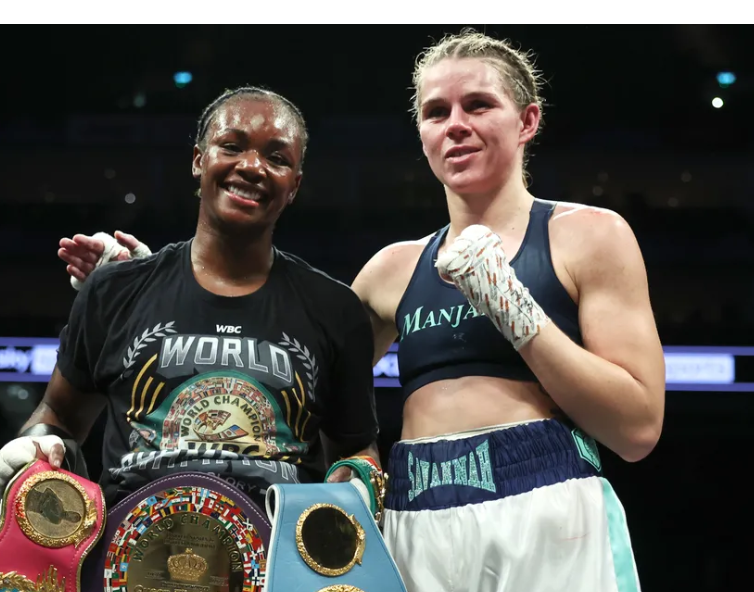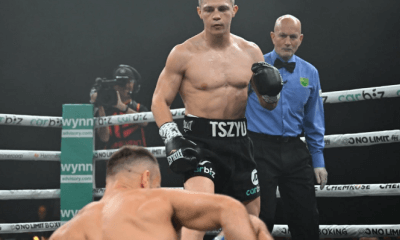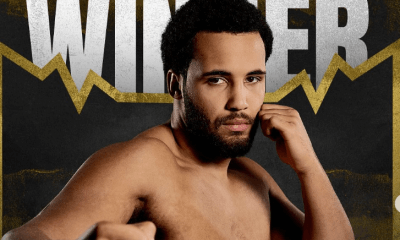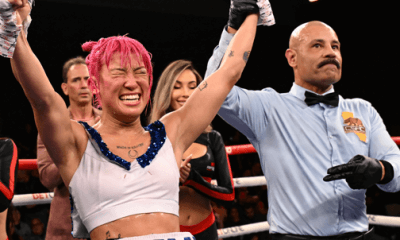Featured Articles
The Hauser Report: Claressa Shields Did What She Had To Do To Win

The Hauser Report: Claressa Shields Did What She Had To Do To Win
Years from now, historians will write that 2022 was the year when women fighters emerged as a significant force in boxing. Much of that history will key on the April 30 fight between Katie Taylor and Amanda Serrano that delivered ten exciting rounds fought at a high skill level before a roaring sold-out crowd at Madison Square Garden. On October 15, an all-women fight card at the O2 Arena in London built upon that platform.
The October 15 card was co-promoted by BOXXER and Salita Promotions in association with Top Rank, streamed in the United States on ESPN+, and televised by Sky Sports in the United Kingdom. Originally scheduled for September 10, it was postponed out of respect for the Royal Family following Queen Elizabeth’s death on September 8.
Alycia Baumgardner outpointed Mikaela Mayer in the first co-featured bout on October 15 to claim the WBC, IBF, and WBO 130-pound belts. But the fight that resonated most with the public and had the most historical significance was Claressa Shields’s unanimous-decision triumph over Savannah Marshall for the WBC, WBA, IBF, and WBO 160-pound titles.
Shields, now 27, won a gold medal in the middleweight division at the 2012 London Olympics (the first year that women’s boxing was an Olympic sport). Four years later, she repeated that achievement at the Rio de Janeiro Olympics as the capstone on a 77-1 amateur record. Since then, she’d won 12 out of 12 professional fights and accumulated belts in three weight divisions. She entered the Marshall bout with the WBC WBA, and IBF 160-pound titles.
Claressa is also given to unrealistic statements, such as telling TMZ, “I spar with men. I drop men. I beat men up all the time. They may be stronger than me, but their boxing ability isn’t like mine. I think I can beat up Keith Thurman. I really do. GGG, he’s older now. I could give GGG a run for his money.”
To put that comment in context, Shields has scored one knockdown and two stoppages in six years as a pro.
Marshall, age 32, was also 12-and-0 in the professional ranks but with ten knockouts. She’d won the WBO 160-pound belt in 2020 and engendered considerable comment when she rendered Femke Hermans unconscious with a brutal left hook in round three of their April 2, 2022, encounter.
It was Marshall who dealt Shields the sole loss (amateur or pro) in Claressa’s sojourn through boxing – a 14-8 decision at the 2012 AIBA Women’s World Championships. Shields was 17 at the time; Marshall was 21. Later that year, Savannah lost in the first round of competition at the London Olympics to Marina Volnova of Kazakhstan (who Shields defeated in the second round). In 2016 in Rio de Janeiro, Marshall lost in the second round of competition to Nouchka Fontijn of the Netherlands (who Shields defeated in the gold-medal bout).
There was some trash-talking at the July 5 kick-off press conference. Marshall told the assembled media that the fight was taking place in the UK “because Claressa doesn’t sell a ticket,” and added, “I’ve knocked out people you went ten rounds with. That’s all you need to know. I’m a better fighter. I’m not just going to beat you. I’m going to hurt you. See you on September 10, babe.”
“I don’t hate nobody,” Shields responded. “But I do have a huge dislike for her. My grandma told me not to use the word ‘hate,’ so I won’t use it.”
Leading up to the then-scheduled September 10 fight, Shields was the more loquacious of the two fighters:
* “Her beating me in 2012 before the Olympics was the fluke of her career. I’ve never seen something like this in boxing before, someone who lives off of an amateur win for ten years. It’s like they’re trying to erase everything I’ve done in the past ten years because I have been dominant in boxing for a decade, since I was seventeen. I won the Olympics. I won it again. I turned pro. I won titles. And it’s like, ‘Wow! It’s still not enough for you guys.'”
* “If her game plan is to try and stand there in the middle of the ring and to out-bang me, she going to be sleeping. If her game plan is to be smart and try to box, move, she’ll last a bit longer. If it has to be a war, it’s going to be a war that I win. If it’s going to be a boxing match, I’m going to win the boxing match. And if it has to be both, I’m prepared to do it all. I live for moments like this.”
* “To all of you that are doubting me, just make sure you apologize after the fight. Say, ‘We were wrong. You’re the best and we respect you,’ and that you respect my hard work and my accomplishments.”
Meanwhile, Marshall had her own take on the impending battle, saying, “I’m going to take her into deep water and drown her in the Thames.”
Then everything changed. On September 8, Queen Elizabeth died, ushering in a period of unprecedented national mourning. Out of respect for the Royal Family, the British Boxing Board of Control ruled that the fight card would be postponed.
“I’m sad about the fight being postponed,” Shields acknowledged. “But I’m a big girl and I understand that the Queen of the country passing has an entire country mourning. Whatever the decision, I’m respectful of it.”
Marshall seemed to take the postponement harder, telling Sky Sports that she went to Buckingham Palace with a sister and a friend to pay respects before adding, “I had a week off, and I needed it. I felt emotionally drained. I didn’t get out of bed for a couple of days after. I was trying to be positive but I was disappointed. I was upset, the ‘it always happens to me’ kind of vibe.”
In due course, the card was rescheduled for October 15. Ten days before the bout, the WBC announced that it had created yet another belt to add to the many baubles that it bestows on fighters; this one a specially-crafted “Elizabethan Belt” (purple, not green) that would be given to the winner of Shields-Marshall.
When fight week arrived, some of the buzz that swirled around the original September 10 date had dissipated. But anticipation was still high.
Peter Fury (who trains Marshall) said of Shields, “She’s got fast hands, she’s good defensively, and she’s good with counters. She puts flurries together well. With her feints, she makes fighters hesitant. Before they know it, she’s in range and teeing off on them with her quick hands.”
And of his own charge, Fury noted, “She’s got the ability to switch people’s lights out, and that’s a different sort of power than most.”
Meanwhile, Shields remained the more quotable of the two fighters, offering a range of thoughts:
* “I’m not worried about Savannah Marshall. Nobody was ever running from her. Nobody was ever scared to come over here and fight her. We said, ‘Let’s do it. And you better punch as hard as you say you can. Because if you don’t have any punching power, it’s going to be a hard night for you.'”
* “Of course, we’ve got to talk about her punching power. She’s going to try to come out there and land a big shot. That’s really all I see. But it’s a boxing match. I may get hit in there. But if she thinks she won’t get hit, then she’s mistaken. If she thinks she is a better boxer than me, she’s mistaken. I’m going to adapt and do whatever I have to do to win and make the fight easy. She can’t outbox me. She’s not very skilled.”
* “I really feel in my spirit that I am going to knock Savannah Marshall out. This is going to be my statement fight. She’s not going to be able to handle my shots.”
This was the first time that a women’s bout had headlined a fight card at the O2 Arena. In keeping with that theme, all eleven bouts on the bill showcased women fighters. The first nine were expected to be relatively easy outings for promoter favorites. Shields-Marshall and Mayer-Baumgardner were another matter.
Mayer, age 32, came into her fight with a 17-0 (5 KOs) ring record. She’d won the WBO and IBF 130-pound belts by decision over Ewa Brodnicka (in 2020) and Maiya Hamadouche (2021) and defended them successfully by decision over Jennifer Han earlier this year.
Baumgardner, age 28, (12-1, 7 KOs) annexed the WBC 130-pound belt with a surprise knockout of Terri Harper last year.
Mayer was a 5-to-2 betting favorite. The women “had to be separated” during a fight-week interview on Sky Sports, again at the final pre-fight press conference, and once more at a post-weigh-in staredown, proving that women fighters can act as silly as the men.
When fight night arrived, the hostilities between them were more muted. Baumgardner prevailed on a 96-95, 96-95, 93-97 split-decision, and ESPN expert commentator Tim Bradley opined, “The next time they do it, I want to see more action.”
Shields-Marshall was far more fan-friendly and a classic confrontation between boxer and puncher.
The women had three common opponents – Sydney LeBlanc, Hannah Rankin, and Femke Hermans. Shields outpointed all three without losing a round on any of the judges’ scorecards. Marshall (in her pro debut) won every round against LeBlanc, stopped Rankin in seven rounds and, as previously noted, knocked Hermans unconscious.
The stakes were high. Whoever won would be elevated to legitimate stardom. Shields was a slight betting favorite. An enthusiastic sold-out crowd of 20,000 witnessed the action.
Marshall knows how to fight. Once the bell for round one sounded, she kept coming forward, firing punches for the entire night. Shields was respectful of Marshall’s power but understood that the only way she could keep Savannah off was to hurt her. Claressa didn’t run. She fired back and often fired first.
A ten-round firefight followed.
Shields was the better boxer, faster, and pulled the trigger more quickly than Marshall did. She was also the more accurate puncher.
Marshall showed more boxing skills than she had in previous fights. Her most effective blows were hooks to the body. And she wasn’t above using her forearms, shoulders, and elbows on the far side of the rules when she and Shields were fighting inside. Claressa didn’t complain. She just fired back.
The women were equally tough.
It was an action fight from beginning to end. Shields showed more fire and firepower than she had in previous outings. She had to in order to win. Each woman gave it everything she had. Both women dug deep in the second half of the fight.
The judges 97-93, 97-93, 94-94 verdict in Shields’s favor was on the mark.
Boxing in the United Kingdom needed a boost in the wake of the ongoing Conor Benn performance-enhancing-drug scandal. Shields and Marshall delivered it.
Thomas Hauser’s email address is thomashauserwriter@gmail.com. His most recent book – In the Inner Sanctum: Behind the Scenes at Big Fights – was just published by the University of Arkansas Press. In 2004, the Boxing Writers Association of America honored Hauser with the Nat Fleischer Award for career excellence in boxing journalism. In 2019, he was selected for boxing’s highest honor – induction into the International Boxing Hall of Fame.
To comment on this story in the Fight Forum CLICK HERE
-

 Featured Articles4 weeks ago
Featured Articles4 weeks agoThe Hauser Report: Zayas-Garcia, Pacquiao, Usyk, and the NYSAC
-

 Featured Articles3 weeks ago
Featured Articles3 weeks agoOscar Duarte and Regis Prograis Prevail on an Action-Packed Fight Card in Chicago
-

 Featured Articles2 weeks ago
Featured Articles2 weeks agoThe Hauser Report: Cinematic and Literary Notes
-

 Book Review2 weeks ago
Book Review2 weeks agoMark Kriegel’s New Book About Mike Tyson is a Must-Read
-

 Featured Articles4 weeks ago
Featured Articles4 weeks agoRemembering Dwight Muhammad Qawi (1953-2025) and his Triumphant Return to Prison
-

 Featured Articles6 days ago
Featured Articles6 days agoMoses Itauma Continues his Rapid Rise; Steamrolls Dillian Whyte in Riyadh
-

 Featured Articles3 weeks ago
Featured Articles3 weeks agoRahaman Ali (1943-2025)
-

 Featured Articles3 weeks ago
Featured Articles3 weeks agoTop Rank Boxing is in Limbo, but that Hasn’t Benched Robert Garcia’s Up-and-Comers


















